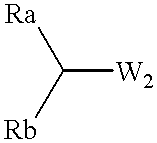Process for preparing optically active compounds
- Summary
- Abstract
- Description
- Claims
- Application Information
AI Technical Summary
Benefits of technology
Problems solved by technology
Method used
Image
Examples
example a
Production of optically active alcohols
Production examples of optically active alcohols are shown below, and the inventive method will further be described in detail. Tables 1, 2 and 3 collectively show reaction substrates, transition metal complexes and optically active amine compounds as chiral ligands, which are to be used as typical examples.
The instrumental analysis was done by using the following individual systems.
NMR: JEOL GSX-400 / VarianGemini-200 (.sup.1 H-NMR sample: TMS, .sup.31 P-NMR standard sample: phosphoric acid)
GLC: SHIMADZU GC-17A(column: chiral CP-Cyclodextrin-b-236-M19)
HPLC: JASCO GULLIVER (column: CHIRALCEL OJ, OB-H, OB, OD)
TABLE 2
TABLE 3
examples 1 through 19
To dry 2-propanol (5.0 ml) were added various amino alcohol compounds (0.05 mmol) as chiral ligands of optically active amine compounds as shown in Table 3 and the ruthenium arene complex (0.0125 mmol) shown in Table 2, for agitation in argon or nitrogen gas atmosphere at 80.degree. C. for 20 minutes, and the resulting mixture was cooled to room temperature, to which were then added frozen and degassed dry 2-propanol (45.0 ml), various carbonyl compounds (5 mmol) deaerated and distilled as shown in Table 1, and a solution of 0.05M KOH in 2-propanol (2.5 ml; 0.125 mmol) in this order, for subsequent agitation at room temperature. After completion of the reaction, dilute hydrochloric acid was added to adjust the resulting mixture to acidity, from which most of 2-propanol was evaporated off under reduced pressure, followed by addition of saturated sodium chloride solution. The resulting product was extracted into ethyl acetate, rinsed with saturated sodium chloride solution several tim...
examples 20 to 23
Using the same method as in Example 1, aminophosphine compound was used as an optically active amine compound for the reaction. The results are collectively shown in Table 4.
PUM
| Property | Measurement | Unit |
|---|---|---|
| Fraction | aaaaa | aaaaa |
| Fraction | aaaaa | aaaaa |
| Fraction | aaaaa | aaaaa |
Abstract
Description
Claims
Application Information
 Login to View More
Login to View More - R&D
- Intellectual Property
- Life Sciences
- Materials
- Tech Scout
- Unparalleled Data Quality
- Higher Quality Content
- 60% Fewer Hallucinations
Browse by: Latest US Patents, China's latest patents, Technical Efficacy Thesaurus, Application Domain, Technology Topic, Popular Technical Reports.
© 2025 PatSnap. All rights reserved.Legal|Privacy policy|Modern Slavery Act Transparency Statement|Sitemap|About US| Contact US: help@patsnap.com



